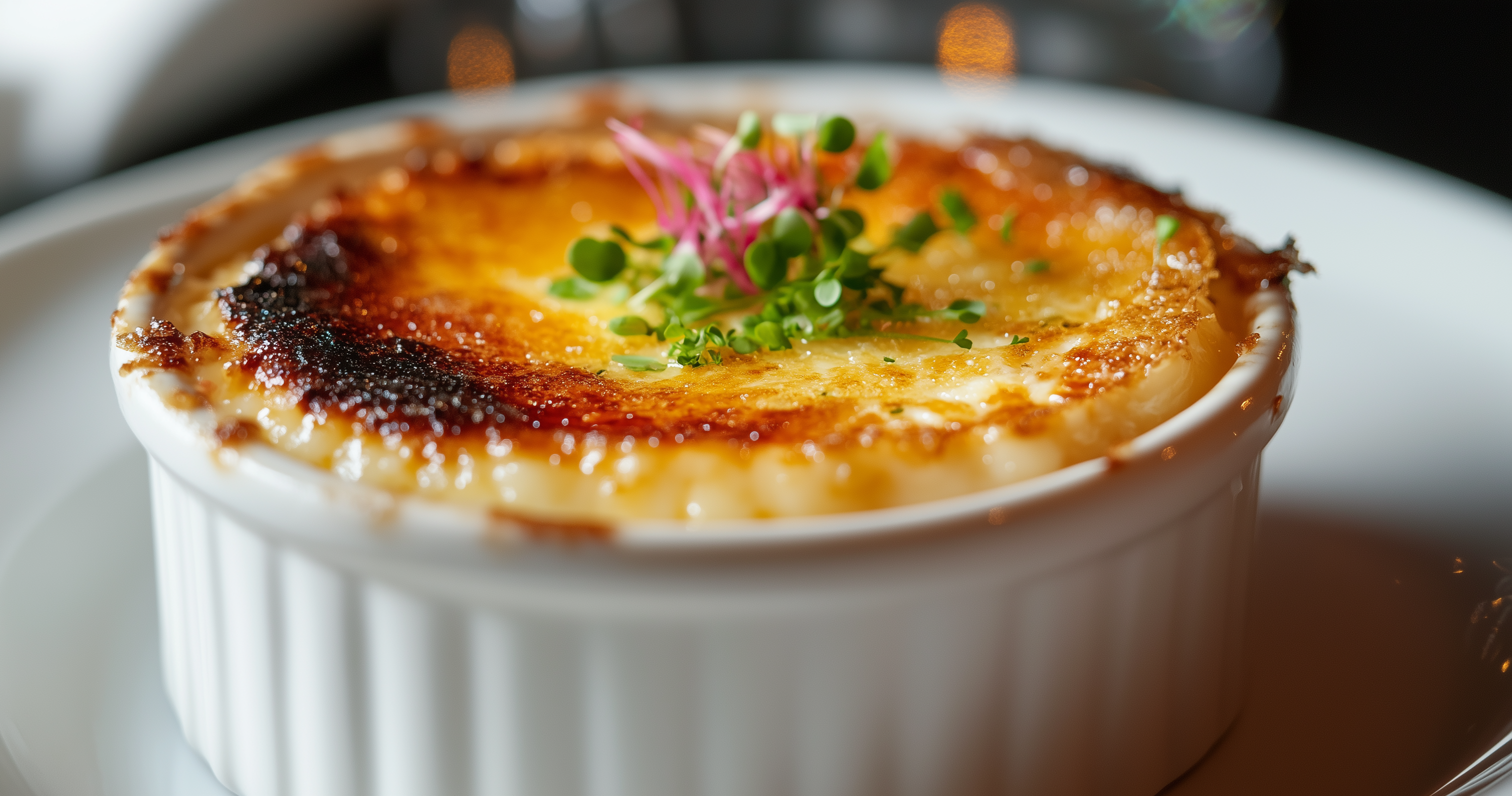Crème brûlée is one of those classic, decadent desserts that combines rich, creamy custard with a perfectly caramelized sugar topping. That satisfying crack when you break through the hardened sugar layer to reveal the silky custard beneath is what makes crème brûlée such a showstopper. But if you’ve ever wondered how to caramelize crème brûlée to create that signature burnt sugar top, this guide is for you.
Caramelizing crème brûlée may seem intimidating, but with the right tools and techniques, anyone can master it. Whether you’re using a kitchen torch or your oven’s broiler, achieving that flawless caramelized topping is within reach. In this article, we’ll cover everything you need to know about how to caramelize crème brûlée, from understanding caramelization to fixing common mistakes and experimenting with flavors..
By the end of this guide, you’ll be ready to make a restaurant-quality crème brûlée at home, complete with a crispy sugar top that cracks with every bite. We’ll even explore how caramelization applies to unique variations like this Crab Brûlée Recipe for a savory twist.
The Science of Caramelization
Before diving into the actual steps of how to caramelize crème brûlée, it’s important to understand what caramelization is. When we talk about caramelizing sugar, we’re referring to the chemical process that occurs when sugar is heated to high temperatures. As the sugar heats up, its molecules break down and reorganize, forming new compounds. These compounds give caramelized sugar its rich, complex flavor, which can include sweet, nutty, and even slightly bitter notes..
When sugar is exposed to heat, it first melts into a liquid, then gradually begins to darken. The temperature at which caramelization begins is around 320°F (160°C), but it can go higher depending on how dark you want the caramel. For crème brûlée, the goal is to achieve a light to medium amber color, which ensures a balanced sweetness and crunch without burning.
Why Caramelization is Crucial in Crème Brûlée
The caramelized sugar topping on crème brûlée isn’t just for aesthetics or texture. It’s a vital part of the overall flavor profile of the dessert. The contrast between the slightly bitter, crispy sugar and the smooth, sweet custard below is what makes this dessert so appealing.
Imagine eating crème brûlée without the burnt sugar top—sure, the custard is delicious, but it would feel incomplete. The caramelized sugar on crème brûlée adds both a crunchy texture and a depth of flavor that balances the richness of the custard. This contrast is what gives crème brûlée its signature appeal and keeps people coming back for more.
The Tools You Need for Caramelizing Crème Brûlée
To properly caramelize the sugar on crème brûlée, you’ll need a few essential tools. While some are must-haves, others are helpful for getting that perfect finish. Let’s look at the most important ones:
1. Kitchen Torch
The kitchen torch is the most common tool for caramelizing crème brûlée. It’s also the easiest to use when you want to control heat and direction precisely. A kitchen torch gives you more control over how quickly and evenly the sugar melts and caramelizes.
How to Use a Kitchen Torch:
Hold the torch about 2 inches away from the sugar. Move the flame in circular motions across the surface of the sugar to ensure even caramelization. The sugar will begin to melt and bubble, then gradually turn golden brown. Be careful not to stay in one spot too long, as this can cause the sugar to burn.
2. Broiler as an Alternative
If you don’t have a kitchen torch, your oven’s broiler can also work for caramelizing sugar. While this method doesn’t give you as much control as a torch, it can still create a beautifully caramelized sugar top.
How to Use a Broiler:
Set your oven’s broiler to high and place your ramekins on the top rack. Broil for 1-2 minutes, rotating the ramekins as needed to ensure even caramelization. Watch carefully to avoid burning the sugar, as it can go from golden to burnt quickly.
3. Granulated Sugar
When it comes to caramelizing crème brûlée, granulated sugar is the best option. It melts evenly and forms the ideal texture for that crisp, caramelized top. Other types of sugar, like brown sugar or powdered sugar, can burn too easily and won’t produce the same crunchy result.
Step-by-Step Guide to Caramelizing Crème Brûlée
1. Chill the Custard
The first and most important step before caramelizing the sugar is to ensure that your custard is fully chilled. The custard needs to be set and cold, as this allows the sugar to harden quickly after caramelization. Once the custards have set in the fridge for at least two hours, they’re ready for caramelizing.
2. Evenly Sprinkle Sugar
After taking your ramekins out of the fridge, use a spoon to sprinkle an even layer of granulated sugar on top of each custard. The sugar should cover the entire surface, creating a thin but uniform layer. Generally, about 1 to 2 teaspoons of sugar per ramekin is sufficient.
Why does an even sugar layer matter? Uneven distribution can lead to uneven caramelization, with some parts burning while others don’t melt properly. The more even your sugar, the better the results will be.
3. Using a Kitchen Torch
If you’re using a kitchen torch, hold the flame about two inches away from the surface of the sugar. Move the torch in small, circular motions to evenly distribute the heat. You’ll start to see the sugar melt, bubble, and then caramelize into a golden-brown color. Once the entire top is caramelized and crisp, let the ramekins sit for a minute to allow the sugar to fully harden.
4. Using a Broiler
If you’re using a broiler, preheat it on high and place your ramekins on the top rack. Broil for 1-2 minutes, keeping a close eye on them to prevent burning. Rotate the ramekins if necessary to ensure even caramelization. When done, the sugar should have formed a hard, golden crust.
For more tips on caramelizing crème brûlée, including broiler techniques, check out The Spruce Eats guide.
Common Mistakes and How to Fix Them
Even seasoned chefs sometimes run into issues when caramelizing crème brûlée. Here’s a look at some common mistakes and how to fix them:
1. Uneven Caramelization
If your sugar caramelizes unevenly, it could be due to an uneven sugar layer. To fix this, make sure the sugar is spread evenly before you start caramelizing. When using a torch, move it in circles for even heat distribution. If you’re using a broiler, rotate the ramekins to ensure that each side gets the same amount of heat.
2. Burnt Sugar
Burnt sugar can happen fast, especially when using a kitchen torch. Keep a close eye on the color of the sugar as it caramelizes. You want a golden-brown color, not dark brown or black. If you’re using a broiler, watch carefully and remove the ramekins as soon as the sugar reaches the desired color.
3. Soggy Sugar Top
If the sugar doesn’t fully harden after caramelizing, it can result in a soggy top. This is often due to the custard not being fully chilled. Always make sure the custard is cold before caramelizing the sugar. Additionally, let the sugar set for a minute after caramelization to ensure it hardens properly.
For more insights on how to avoid these common mistakes, take a look at this detailed guide from Carlsbad Cravings.
Adding Flavor to Your Caramelized Brûlée
While traditional crème brûlée uses plain granulated sugar for caramelization, you can experiment with different flavors and techniques to customize your brûlée topping.
1. Brown Sugar for a Richer Flavor
If you want a deeper, more complex flavor, try using brown sugar instead of white granulated sugar. The molasses in brown sugar gives the caramelized top a rich, earthy taste. However, brown sugar burns more quickly, so you’ll need to watch it carefully as it caramelizes.
2. Flavored Sugars for Added Depth
You can also infuse your sugar with flavors before caramelizing. For example, try mixing granulated sugar with vanilla beans, citrus zest, or cinnamon to give the topping a subtle, aromatic twist. This works especially well with custard recipes that already incorporate complementary flavors.
3. Savory Brûlée Toppings
For a more savory take on caramelization, like in this Crab Brûlée Recipe, you can replace the sugar with a cheese topping. Grated parmesan or Gruyère caramelizes beautifully under the broiler, adding a salty, savory contrast to the smooth custard. This technique works particularly well for savory appetizers or side dishes.
Caramelizing Different Types of Brûlée
Crème brûlée isn’t the only dish that benefits from a caramelized sugar topping. Other variations of brûlée, such as créma catalana from Spain or even flavored custards like coffee or chocolate, can also be caramelized. The technique remains the same, but the flavors of the custard may change the final taste of the caramelized sugar.
For instance, a chocolate brûlée topped with caramelized sugar can create an indulgent, almost s’mores-like flavor. Coffee brûlée, on the other hand, pairs well with a hint of cinnamon or nutmeg mixed into the sugar before caramelizing. These variations give you endless possibilities for experimenting with different flavors.
Want to learn more about the origins of the caramelized topping on crème brûlée? Check out this insightful article on the history of burnt sugar.
Conclusion: Perfecting Your Caramelized Brûlée
Mastering how to caramelize crème brûlée is an essential skill for any home cook looking to elevate their dessert game. With a little practice, you’ll be able to create that signature sugar top with ease, impressing your friends and family every time.
Remember, the key to how to caramelize crème brûlée perfectly is patience and attention to detail. Always start with a fully chilled custard, use an even layer of sugar, and carefully control the heat. Whether you’re using a kitchen torch or a broiler, follow the steps outlined here, and soon you’ll have a flawless crème brûlée every time..
And don’t be afraid to get creative! Once you’ve mastered the basics, experiment with new flavors, toppings, and variations. Whether it’s a savory brûlée or one infused with spices, the possibilities are endless.
So grab your torch (or broiler) and get caramelizing!

